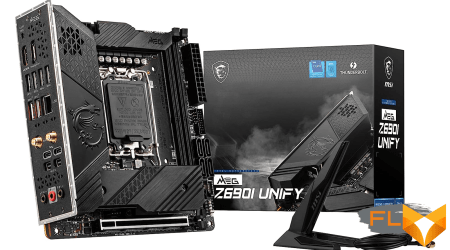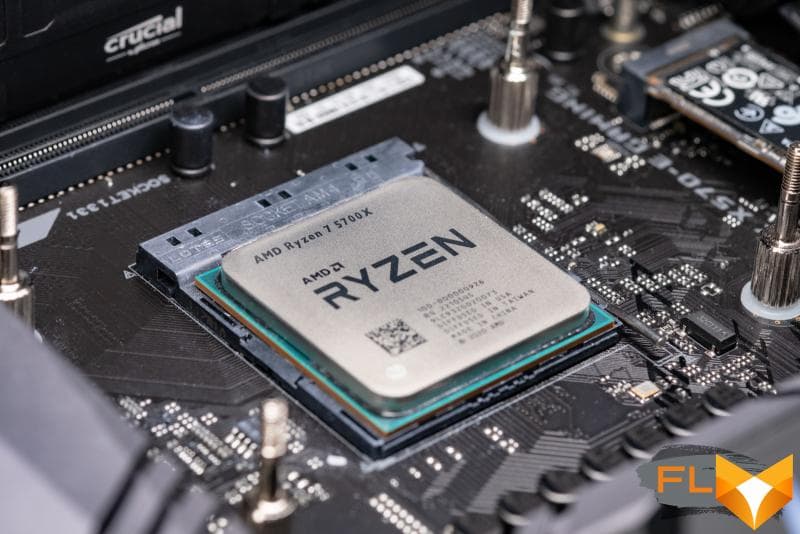


In early April, AMD, finally coping with the shortage of Zen 3 semiconductor crystals, significantly expanded the range of Ryzen 5000 processors. Two eight-core processors were among the new products. One of them, enhanced by the additional 3D cache Ryzen 7 5800X3D, has already received a personal review on our website. But there is also a second newly arrived eight-core representative of the same family – a more modest Ryzen 7 5700X in terms of characteristics. We’ll talk about him today.
At the end of 2020, when AMD released the Ryzen 5000 lineup, it included the smallest possible set of representatives in it – only four processors and only one octa-core among them – the $ 450 Ryzen 7 5800X. Then it was due to the overload of TSMC’s production capacity, which could not produce the desired number of 7nm semiconductor chips for AMD, which forced the latter to get out both by artificially narrowing the assortment and by overpricing. In many ways, this is why the Ryzen 7 5800X has long been the only eight-core Zen 3 for desktop systems, and has accumulated a lot of complaints during its existence. In the list of which, in addition to the high price, there was also a hot temper. For the octa-core Zen 3, AMD has chosen to send semiconductor chips with the highest leakage currents that could not get into any other models. Therefore, Ryzen 7 5800X, as a rule, use higher supply voltages than other Zen 3s and heat up more than the rest of the family.
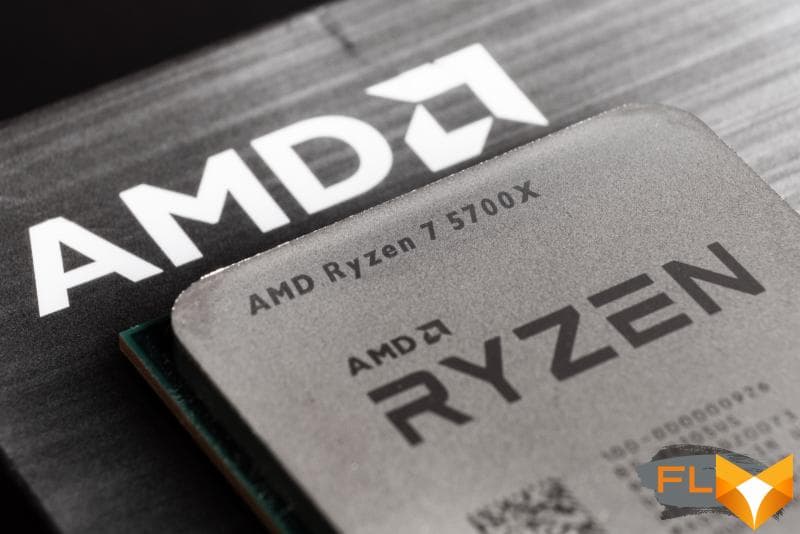
But finally, all the shortcomings of the Ryzen 7 5800X became visible with the advent of the competing Intel Alder Lake family. The eight-core processor offered by AMD was not able to compete not only with the representatives of the Core i7 series, but even with the cheaper Core i5-12600K one and a half times. In other words, the emergence of new eight-core Zen 3 for desktop PCs is in many ways a forced step that AMD took in order to maintain its market position until Raphael, processors based on the Zen 4 microarchitecture, come out. to compete with the Core i7-12700K in games was assigned to the Ryzen 7 5800X3D, and the Ryzen 7 5700X became a top-for-your-money offering with a MSRP of $299, roughly on par with the Core i5-12600K.
Along with the revision of the positioning, AMD also tried to fix the second big drawback of the Ryzen 7 5800X – energy and thermal characteristics. Therefore, the Ryzen 7 5700X is based on semiconductor crystals of the more recent B2 stepping – the same one that got into the Ryzen 7 5800X3D. This silicon is obviously of the best quality, which is directly reflected in the passport characteristics of the new product – the thermal package of the Ryzen 7 5700X is set not to 105, but to 65 watts.
However, despite all the measures taken, the appeal of the Ryzen 7 5700X is far from certain. Zen 3 processors entered the market at a time when Intel had only the tenth generation of Core on the Skylake microarchitecture. Since then, the Blues have made two strong leaps forward, and the Ryzen 5000 family has found itself in a position of obsolete. And it’s far from certain that the tweaked characteristics of the Ryzen 7 5700X, along with a reduced price, will allow it to become a relevant option that really makes sense to pay attention to in the current conditions. In addition, AMD itself dealt a serious blow to the market positions of the novelty, which lowered the price of the Ryzen 7 5800X in such a way that both eight-cores began to cost approximately the same in retail.
For all of the above reasons, the Ryzen 7 5700X received a separate review in which we will try to figure out whether AMD managed to return the attractiveness of the eight-core consumer Zen 3 and which of the three current generation Ryzen 7 looks now the most reasonable choice.
Ryzen 7 5700X in detail
If a generation of processors lingers on the market for too long, it is supplemented with new models – this is the tactic used by both AMD and Intel. Therefore, the update of the Ryzen 5000 lineup was not a big surprise: this family of processors has been offered by AMD for more than a year and a half. However, the set of fresh models came out somewhat unexpected: the new Ryzen did not receive the XT suffix in the names and did not become overclocked modifications of existing options, but, on the contrary, turned out to be slower and more affordable.
The Ryzen 7 5700X is a prime example of this approach. We are talking about the same eight-core Vermeer core as in the Ryzen 7 5800X, but with the thermal package frames clamped. While the old flagship octa-core has a TDP of 105W and is capped at 142W, the TDP of the new octa-core Ryzen 7 5700X is set at 65W and the PPT (Package Power Tracking) bar has been pushed down to a very modest 76W. In other words, the Ryzen 7 5700X is not only almost twice as economical as the octa-core Zen 3 of its predecessor, but also a processor that consumes less than the Ryzen 7 3700X (which was set to a PPT limit of 88W).
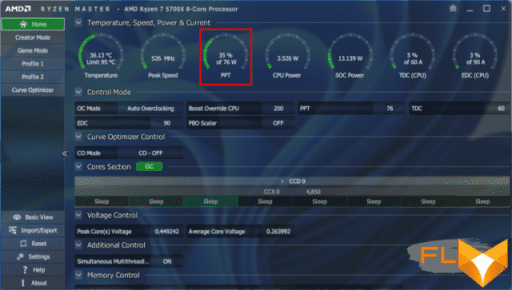
Such aggressive power limiting is not in vain for other characteristics – even the new B2 silicon stepping and the rebuilt scheme for selecting suitable semiconductor crystals with an emphasis on low leakage currents do not save. Compared to the Ryzen 7 5800X, the new Ryzen 7 5700X received a 400 MHz lower nominal clock speed. And in practice, with real multi-threaded loads, the gap can be even more noticeable. For example, the real frequency of the Ryzen 7 5700X with multi-threaded rendering in Cinebench R23 is below 3.7 GHz, while the Ryzen 7 5800X runs freely at 4.5 GHz under similar conditions.

However, such a dramatic gap in frequency is observed only in multi-threaded and resource-intensive workloads. The maximum achievable frequency for the old and new eight-core differs only by 100-200 MHz – with a single-threaded load, the Ryzen 7 5700X is capable of overclocking up to 4.6-4.65 GHz. And in general, in terms of passport frequencies, the Ryzen 7 5700X resembles the Ryzen 7 5800X3D, only without the additional 64 MB of L3 cache.
| Ryzen 7 5800X3D | Ryzen 7 5800X | Ryzen 7 5700X | |
|---|---|---|---|
| Platform | Socket AM4 | Socket AM4 | Socket AM4 |
| Microarchitecture | Zen 3 | Zen 3 | Zen 3 |
| Technological process, mm | 7/12 | 7/12 | 7/12 |
| Cores/Threads | 8/16 | 8/16 | 8/16 |
| Frequency (nominal/turbo), GHz | 3.4-4.5 | 3.8-4.7 | 3.4-4.6 |
| L3 cache, MB | 96 | 32 | 32 |
| TDP, W | 105 | 105 | 65 |
| Memory | DDR4-3200 | DDR4-3200 | DDR4-3200 |
| PCIe lanes | 24 × Gen4 | 24×Gen4 | 24×Gen4 |
| Integrated Graphics | No | No | No |
| Official price | $449 | $449 | $299 |
But the Ryzen 7 5700X won a lot in terms of temperature. If the Ryzen 7 5800X was characterized by operating temperatures of the order of 70-80 degrees, even when using powerful liquid cooling systems, you need to try very hard to warm up the Ryzen 7 5700X to 70 degrees. For this reason, it can be used without problems with low-cost motherboards with weak VRM circuits and with mid-range air coolers. Curiously, AMD itself decided not to bundle the new product with any kind of cooler, although other 65-watt processors from the company come with Wright Stealth.
The reason for the lack of a complete cooling system in the delivery, apparently, is that the Ryzen 7 5700X is not supposed to be used in the narrow framework of limited consumption and heat dissipation. AMD is confident that most users will opt for additional performance and turn off the stifling 76-watt PPT limit, since it is very simple to do this – just activate the Precision Boost Override function in the motherboard BIOS (or in the Ryzen Master utility).
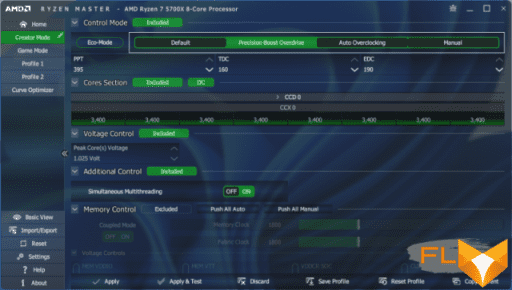
This leads to cardinal changes in the behavior of the processor, for example, its frequency at full multi-threaded load increases immediately by 500-600 MHz – up to 4.3 GHz. But even in this state, the Ryzen 7 5700X falls short of the frequencies of the Ryzen 7 5800X – you can compare the frequency formula of both CPUs using the given frequency graph depending on the number of executable threads. The Cinebench R23 rendering test was used as a reference load in this graph.
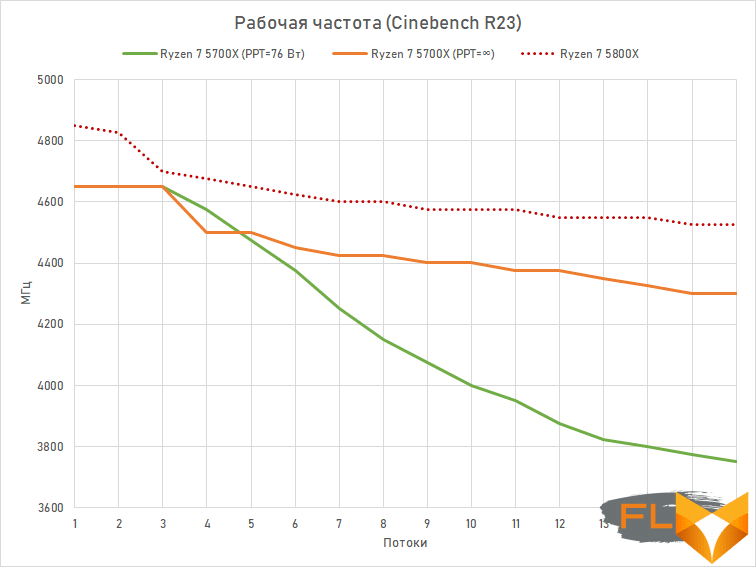
It turns out that making a complete analogue of the Ryzen 7 5800X out of the Ryzen 7 5700X with a slight movement of the hand will not work, although the frequency of the younger eight-core processor grows very noticeably when the consumption limits are removed. But this seems not enough, because in the real world the price difference between the Ryzen 7 5700X and Ryzen 7 5800X has shrunk to near-zero values. And if both processors cost the same, then why buy a weaker one?
The answer to this question may be the more favorable thermal conditions of the Ryzen 7 5700X. There are prerequisites for this – at least a new stepping of a semiconductor crystal.
Power consumption and temperatures
And indeed, during the consumption measurement, the Ryzen 7 5700X looks clearly better than the Ryzen 7 5800X. Even with the PPT limit removed, the new processor works more economically, which is largely due to lower operating voltages, which lie in the range of 1.2-1.35 V (against 1.3-1.45 V for the Ryzen 7 5800X). As a result, even in rendering, the Ryzen 7 5700X consumes no more than 121 watts, and in games its consumption is about 100 watts.
At the same time, the graphs clearly show that if you operate the Ryzen 7 5700X without any additional settings, with the 76-watt PPT limit activated by default, its capabilities are limited by this very limit – consumption almost always rests on the set maximum, forcing the processor reset the frequency both in resource-intensive tasks and in regular games. Therefore, this mode can only be used to reduce the load on the cooling system or power system: in the face of active restrictions, the Ryzen 7 5700X is a surprisingly undemanding and cold eight-core.
This can be estimated from the following temperature curves. (In the experiments, the same custom LSS system based on EKWB components was used for cooling.)
Under consumption-limited conditions, the Ryzen 7 5700X shows temperatures no higher than 55 degrees, and this is really an outstanding result for an eight-core carrier of the Zen 3 microarchitecture. degrees in multi-threaded rendering and 70 degrees in games. In other words, if the Ryzen 7 5800X scared you off with its unbridled heating, then the new eight-core from its predecessor did not adopt this unpleasant trait.
In passing, we recall that another processor released in April, the innovative Ryzen 7 5800X3D with 3D cache, demonstrates moderate heating and power consumption. It looks like AMD is purposefully trying to improve the power efficiency of its solutions, and the new Zen 3 die stepping, which was included in both new products, allowed us to take a big step in this direction.
Overclocking
Unfortunately, the new core stepping and a change in the approach to selecting semiconductor chips from the Ryzen 7 5700X did not make the processor well overclockable. The maximum frequency that we managed to achieve with a synchronous increase in frequency across all cores was 4.5 GHz.
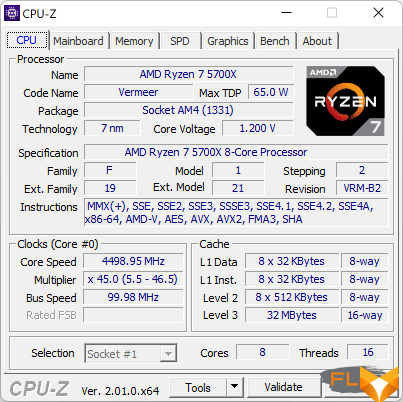
Stable operation in this state was possible with an increase in the supply voltage to 1.2 V and activation of the fourth level of Load-Line Calibration. At the same time, the processor temperature at these settings in stress tests like Prime95 reached 90 degrees, which can be considered acceptable heating, taking into account the extreme load.
Thus, according to the results of simple overclocking, the Ryzen 7 5700X almost does not differ from its older brother, and, therefore, in the year and a half that has passed since the appearance of the first Zen 3, practically nothing has changed in terms of overclocking potential. That is, the most effective approach to increasing the performance of Ryzen processors remains overclocking the memory subsystem and using the Precision Boost Override function (ideally in conjunction with Curve Optimizer). However, in any case, the Ryzen 7 5700X is no better than the Ryzen 7 5800X here.
Description of the test system and testing methodology
The main rivals of the Ryzen 7 5700X are AMD’s other eight-core Ryzen 7 5800X and Ryzen 7 5800X3D processors, as well as the Core i5-12600K processor, which is in the same price category. But by tradition, we expanded the list of test participants so that they included both more expensive and cheaper processors.
As a result, the test system included the following components:
- Processors:
- AMD Ryzen 9 5950X (Vermeer, 12 cores + SMT, 3.4-4.9GHz, 64MB L3);
- AMD Ryzen 9 5900X (Vermeer, 12 cores + SMT, 3.7-4.8GHz, 64MB L3);
- AMD Ryzen 7 5800X3D (Vermeer, 8 cores + SMT, 3.4-4.5GHz, 96MB L3);
- AMD Ryzen 7 5800X (Vermeer, 8 cores + SMT, 3.8-4.7GHz, 32MB L3);
- AMD Ryzen 7 5700X (Vermeer, 8 cores + SMT, 3.4-4.6GHz, 32MB L3);
- AMD Ryzen 5 5600X (Vermeer, 6 cores + SMT, 3.7-4.6GHz, 32MB L3);
- Intel Core i9-12900K (Alder Lake, 8P+8E-cores + HT, 3.5-5.3/2.4-3.9GHz, 30MB L3);
- Intel Core i7-12700K (Alder Lake, 8P+4E-cores + HT, 3.6-5.0/2.7-3.8GHz, 25MB L3);
- Intel Core i5-12600K (Alder Lake, 6P+4E-cores + HT, 3.7-4.9/2.8-3.6GHz, 20MB L3);
- Intel Core i5-12400 (Alder Lake, 6P cores + HT, 2.5-4.4GHz, 18MB L3).
- CPU cooler: custom coolant EKWB.
- Motherboards:
- ASUS ROG Strix X570-E Gaming WiFi (Socket AM4, AMD X570);
- ASUS ROG Strix Z690-F Gaming WiFi (LGA1700, Intel Z690).
- Memory:
- 2x16GB DDR4-3600 SDRAM, 16-18-18-38 (Crucial Ballistix RGB BL2K16G36C16U4BL);
- 2x16GB DDR5-6000 SDRAM, 40-40-40-76 (G.Skill Trident Z5 RGB F5-6000U4040E16GX2-TZ5RK).
- Video Card: NVIDIA GeForce RTX 3090 Founders Edition (GA102, 1395-1695/19500MHz, 24GB GDDR6X 384-bit).
- Disk subsystem: Intel SSD 760p 2TB (SSDPEKKW020T8X1).
- Power supply: ASUS ROG-THOR-1200P (80 Plus Titanium, 1200 W).
All compared processors were tested with canceled artificial consumption restrictions. This means that the PPT limits (for the AMD platform) and PL1/PL2 (for the Intel platform) are ignored, instead the maximum possible frequencies are used in order to obtain maximum performance.
The memory subsystems were configured using XMP profiles. Socket AM4 processors were tested with DDR4-3600, and Alder Lake with DDR5-6000.
Testing was performed on the Microsoft Windows 11 Pro (21H2) Build 22000.708 operating system with installed updates and using the following set of drivers:
- AMD Chipset Driver 4.06.10.651;
- Intel Chipset Driver 10.1.18838.8284;
- Intel SerialIO Driver 30.100.2105.7;
- Intel Management Engine Interface 2124.100.0.1096;
- NVIDIA GeForce 516.40 Driver
Description of the tools used to measure computing performance:
Comprehensive benchmarks:
- Futuremark PCMark 10 Professional Edition 2.1.2525 – testing in Essentials scenarios (typical work of the average user: launching applications, surfing the Internet, video conferencing), Productivity (office work with a word processor and spreadsheets), Digital Content Creation (creating a digital content: photo editing, non-linear video editing, rendering and visualization of 3D models).
- 3DMark Professional Edition 2.22.7359 – testing in the CPU Profile 1.1 scenario with one and eight active threads, as well as at the maximum possible processor load.
Applications:
- 7-zip 22.00 – archiving speed testing. The time taken by the archiver to compress a directory with various files with a total volume of 4.6 GB is measured. Uses LZMA2 algorithm and maximum compression ratio.
- Adobe Photoshop 2022 23.4.1 – Graphics performance testing. The speed of execution of the Procyon Photo Editing test script, which simulates the typical processing of an image taken by a digital camera, is measured.
- Adobe Photoshop Lightroom Classic 11.4 – Performance test for batch processing of a series of RAW images. The speed of execution of the Procyon Photo Editing test script, which simulates color correction and editing of a set of 130 photos, is measured.
- Adobe Premiere Pro 2022 22.4.0 – Video editing performance test. The speed of execution of the Procyon Video Editing test script, which simulates the preparation for publication on YouTube of a video composed of 4K fragments shot on a GoPro camera, is measured.
- Blender 3.2.0 – testing the speed of the final rendering in one of the popular free packages for creating three-dimensional graphics. The duration of building the final classroom model from Blender Benchmark is measured.
- Handbrake 1.6.0 – testing the speed of transcoding 2160p@24FPS AVC video with a bitrate of about 42 Mbps to more advanced formats. x265 and AV1 (SVT) software encoders are used.
- Mathworks Matlab R2021b (9.11.0) – testing the speed of engineering and mathematical calculations in a popular mathematical package. A standard benchmark is used, which includes matrix and vector operations, the solution of differential and symmetric sparse linear systems of equations, as well as the construction of 2D and 3D plots.
- Microsoft Visual Studio 2022 (17.2.5) – Compile time measurement for a large MSVC project – a professional package for creating 3D graphics Blender version 3.3.0 Alpha.
- POV-Ray 3.7 – testing rendering speed using ray tracing. The performance of the built-in benchmark is measured.
- Stockfish 15.0 – testing the speed of the popular chess engine. The speed of enumeration of options in the position “1q6/1r2k1p1/4pp1p/1P1b1P2/3Q4/7P/4B1P1/2R3K1 w” is measured.
- Topaz Video Enhance AI v2.6.4 – performance testing in an AI-based program to improve video detail. The test uses the original video at 640×360 resolution, which is scaled up twice using the Artemis High Quality v12 model.
- V-Ray 5.00 – Benchmark the performance of a popular rendering system using the standard V-Ray Benchmark Next application.
Games:
- Chernobylite. Resolution 1920 × 1080: Graphics Quality = Ultra. Resolution 3840 × 2160: Graphics Quality = Ultra.
- Civilization VI: Gathering Storm. Resolution 1920×1080: DirectX 12, MSAA=4x, Performance Impact=Ultra, Memory Impact=Ultra. Resolution 3840 × 2160: DirectX 12, MSAA = 4x, Performance Impact = Ultra, Memory Impact = Ultra.
- Cyberpunk 2077. 1920×1080 resolution: Quick Preset = Ultra. Resolution 3840 × 2160: Quick Preset = Ultra.
- Far Cry 6. Разрешение 1920 × 1080: Graphics Quality = Ultra, HD Textures = On, Anti-Aliasing = TAA. Resolution 3840 × 2160: Graphics Quality = Ultra, Anti-Aliasing = TAA.
- Hitman 3. 1920 × 1080 resolution: Super Sampling = 1.0, Level of Detail = Ultra, Texture Quality = High, Texture Filter = Anisotropic 16x, SSAO = Ultra, Shadow Quality = Ultra, Mirrors Reflection Quality = High, SSR Quality = High, Variable Rate Shading = Quality. Resolution 3840 × 2160: Super Sampling = 1.0, Level of Detail = Ultra, Texture Quality = High, Texture Filter = Anisotropic 16x, SSAO = Ultra, Shadow Quality = Ultra, Mirrors Reflection Quality = High, SSR Quality = High, Variable Rate Shading =Quality.
- Horizon Zero Dawn. Resolution 1920 × 1080: Preset = Ultimate Quality. Resolution 3840 × 2160: Preset = Ultimate Quality.
- Marvel’s Guardians of the Galaxy. Resolution 1920×1080: Graphics Preset = Ultra. Resolution 3840 × 2160: Graphics Preset = Ultra.
- Serious Sam: Siberian Mayhem. Resolution 1920 × 1080: Direct3D 11, CPU Speed = Ultra, GPU Speed = Ultra, GPU Memory = Ultra. Resolution 3840 × 2160: Direct3D 11, CPU Speed = Ultra, GPU Speed = Ultra, GPU Memory = Ultra.
- Shadow of the Tomb Raider. Resolution 1920×1080: DirectX12, Preset=Highest, Anti-Aliasing=TAA. Resolution 3840 × 2160: DirectX12, Preset = Highest, Anti-Aliasing = Off.
- The Riftbreaker. Resolution 1920 × 1080: DirectX12, Texture Quality = High, Raytraced soft shadows = On, Ray traced shadow quality = Ultra, Raytraced ambient occlusion = On. Resolution 3840 × 2160: DirectX12, Texture Quality = High, Raytraced soft shadows = On, Ray traced shadow quality = Ultra, Raytraced ambient occlusion = On.
- Total War: Warhammer III. Resolution 1920 × 1080: Quality = Ultra. Resolution 3840 × 2160: Quality = Ultra.
- Watch Dogs Legion. Resolution 1920×1080: DirectX 12, Quality=Ultra, RTX=Off, DLSS=Off. Resolution 3840 × 2160: DirectX 12, DirectX 12, Quality = Ultra, RTX = Off, DLSS = Off.
In all gaming tests, the results are the average number of frames per second, as well as the 0.01-quantile (first percentile) for FPS values. The use of the 0.01-quantile instead of the minimum FPS is due to the desire to clean up the results from random bursts of performance that were provoked by reasons not directly related to the operation of the main components of the platform.
What’s wrong with Ryzen 7 5700X with default settings
The main feature of the Ryzen 7 5700X is its improved energy efficiency. Cutting the TDP down to 65W and limiting the maximum power consumption to 76W makes the processor so cold that it can be used without hesitation in compact systems with relatively simple coolers and motherboards with low-power power circuits. However, all this is not at all free – the gap between the Ryzen 7 5700X and the Ryzen 7 5800X at operating frequencies at default settings reaches 800 MHz, or in relative terms up to 20%. Such a gap will definitely cost a pretty serious performance penalty, and therefore we recommend that you immediately remove the power limits for the Ryzen 7 5700X by activating the Precision Boost Override feature.
In this mode, the processor will be hotter, but still it will not heat up as much as the Ryzen 7 5800X. But the lag in performance will noticeably decrease – without restrictions on consumption, the gap in the frequency of the older and younger eight-core is only about 200 MHz. It is in this mode – without artificial limits – that we tested the Ryzen 7 5700X as part of this review, assuming that most users will want to use this processor in the same way – without striving for maximum energy savings.
However, for the sake of completeness, we compared the performance of the Ryzen 7 5700X with and without power consumption capped at 76W. The results are shown in the table.
| Ryzen 7 5700X | Relative difference | ||
|---|---|---|---|
| PPT=∞ | PPT=76W | ||
| 7-zip 21.02 seconds | 183.9 | 184.9 | 0.5% |
| Blender 3.2 seconds | 359.2 | 404.4 | 12.6% |
| HandBrake 1.6 (SVT-AV1), fps | 7,17 | 6,32 | 13.4% |
| HandBrake 1.6 (x265), fps | 10.58 | 9.45 | 12.0% |
| Lightroom Classic 11.4 points | 11848 | 11540 | 2.7% |
| Matlab R2021b, points | 70,36 | 65.53 | 7.4% |
| Photoshop 2022 Points | 9662 | 9271 | 4.2% |
| POV-Ray 3.7, pixels/s | 5239 | 4618 | 13.4% |
| Premiere Pro 2022 points | 7221 | 7063 | 2.2% |
| Stockfish 15, kNodes/s | 15335 | 12353 | 24.1% |
| Topaz Video Enhance AI 2.6, fps | 1,9 | 1.66 | 14.5% |
| Visual Studio 2022 seconds | 531.1 | 579 | 9.0% |
| V-Ray 5.00, ksamples/m | 11035 | 9859 | 11.9% |
One setting – Precision Boost Override – allows you to increase the performance of the Ryzen 7 5700X in applications for processing and content creation by an average of 10% while maintaining all the usual energy-saving technologies, with automatic frequency adjustment to load and without compromising system stability. It seems strange to sacrifice this free premium, especially since in some cases you can win even more – up to 24% performance.
True, as it turns out in the tests, gaming performance does not suffer so much from the forced limitation of power consumption – we are talking about units of FPS percent. Details are in the following table.
| 1080p, Ultra quality | Ryzen 7 5700X | Relative difference | |
|---|---|---|---|
| PPT=∞ | PPT=76W | ||
| Civilization VI: Gathering Storm | 194.2 | 185.9 | 4.5% |
| Chernobylite | 207.6 | 205.6 | 1.0% |
| Cyberpunk 2077 | 134.2 | 134.1 | 0.1% |
| Far Cry 6 | 126.9 | 125.1 | 1.4% |
| Hitman 3 | 143.2 | 138.7 | 3.2% |
| Horizon Zero Dawn | 168 | 164.9 | 1.9% |
| Marvel’s Guardians of the Galaxy | 146 | 143.2 | 2.0% |
| Serious Sam: Siberian Mayhem | 138.9 | 133 | 4.4% |
| Shadow of the Tomb Raider | 220.9 | 218.7 | 1.0% |
| The Riftbreaker | 147.4 | 145.4 | 1.4% |
| Total War: Warhammer III | 121.7 | 120.8 | 0.7% |
| Watch Dogs Legion | 114.8 | 112.8 | 1.8% |
Thus, in purely gaming systems, you don’t have to resort to disabling consumption limits – the losses will not be so great, and the processor’s heating, as was shown earlier, will be ten degrees lower.
Performance in complex benchmarks
The performance of the Ryzen 7 5700X in PCMark 10, which simulates everyday work in common applications, does not look unexpected. This processor is slower than the older model, the Ryzen 7 5800X, but faster than the Ryzen 7 5800X3D, which does not allow you to turn off the consumption limits, and therefore operates at even lower clock speeds. As a result, the results of the eight-core Ryzen 7 5700X are somewhere between those of the six-core Core i5-12400 and the Core i5-12600K processor with a 6P + 4E nuclear formula. And it looks pretty weak, because the official cost of the Ryzen 7 5700X is higher than that of the Core i5-12600K.
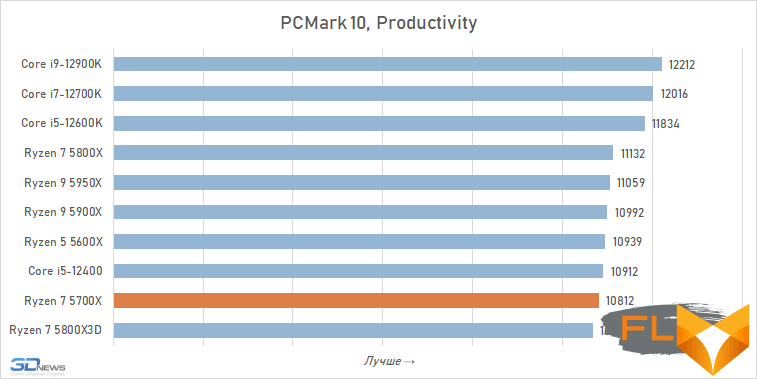
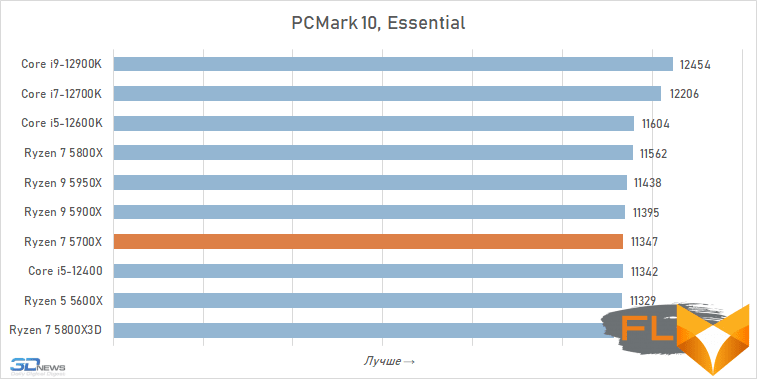
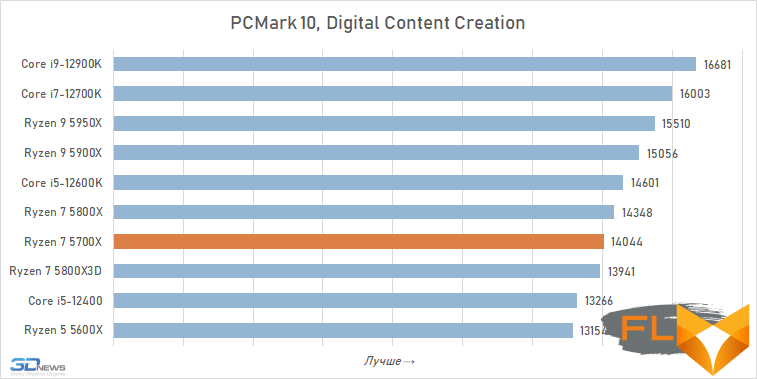
With gaming performance estimates made by the 3DMark CPU Profile synthetic benchmark, the situation is about the same. Regardless of how many threads are tested – with one, eight, or the maximum number – the Ryzen 7 5700X is always weaker than the ten-core Core i5-12600K. Moreover, in terms of single-threaded performance, it loses even to the six-core Core i5-12400. Nevertheless, in the Ryzen lineup, this processor looks quite logical – it offers an intermediate level of performance between the Ryzen 5 5600X and Ryzen 7 5800X, showing where a large amount of cache memory is not so important, better results than the Ryzen 7 enhanced 3D cache 5800X3D.
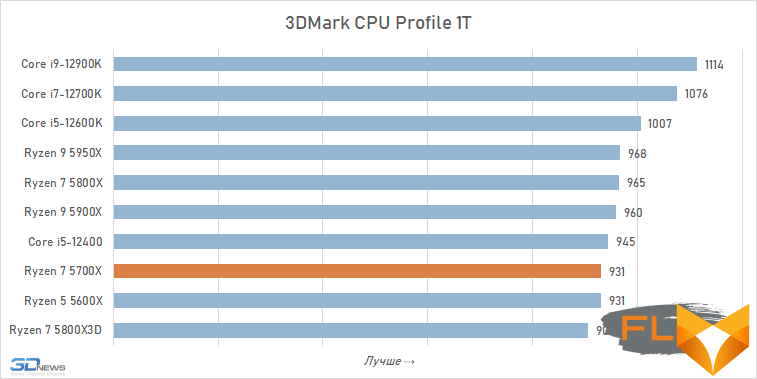
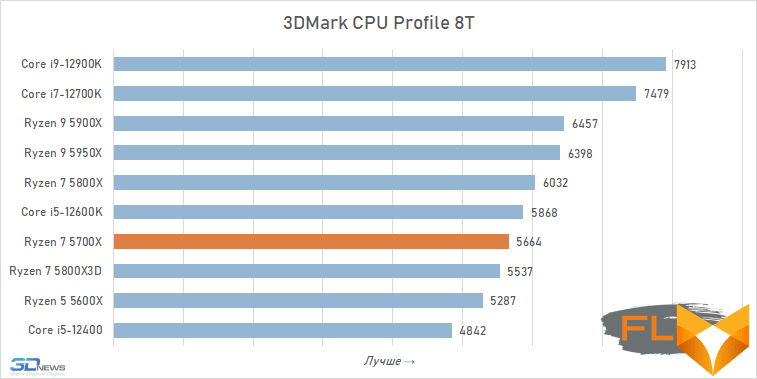
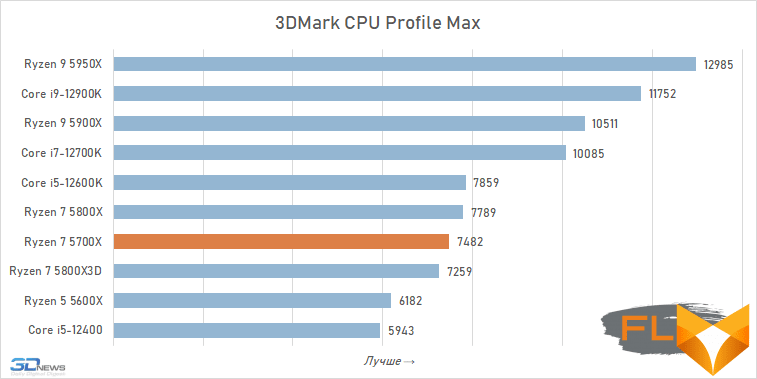
Application performance
With the role of a more affordable alternative to the Ryzen 7 5800X, the new Ryzen 7 5700X could handle it without much difficulty. The difference in the performance of these processors in resource-intensive applications does not exceed 6%, and averages about 3.5%. However, in the same price category with the Ryzen 7 5700X, much more attractive offers coexist in the face of competitor processors. The already mentioned Core i5-12600K, which can be bought cheaper than the younger eight-core Zen 3, is faster in “heavy” work scenarios by about 8%. Thus, the new AMD processor does not solve the problem of updating the Ryzen 5000 lineup as well as we would like.
Moreover, the market position of the Ryzen 7 5700X is further undermined by AMD itself, selling the Ryzen 7 5800X and Ryzen 7 5700X at a very close price, which ultimately makes the purchase of a new processor with an eye to use in production systems for content creation and processing virtually meaningless .
And one more curious detail: Ryzen 7 5700X in resource-intensive applications almost does not differ in performance from Ryzen 7 5800X3D. That is, strengthening an eight-core processor with a 3D cache almost does not give real results in those tasks that are used by specialists in their professional activities.
Rendering:

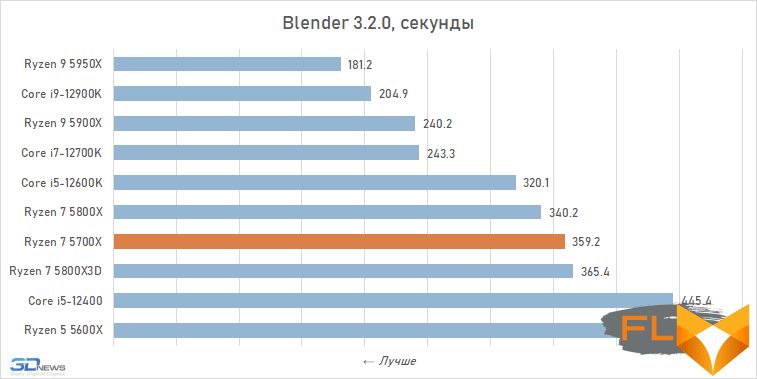
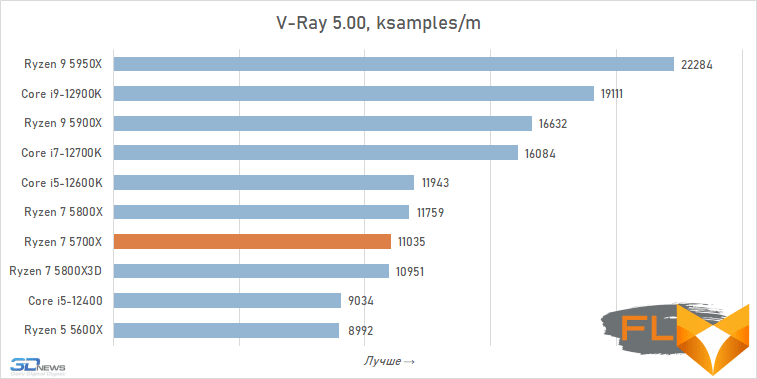
Photo processing:
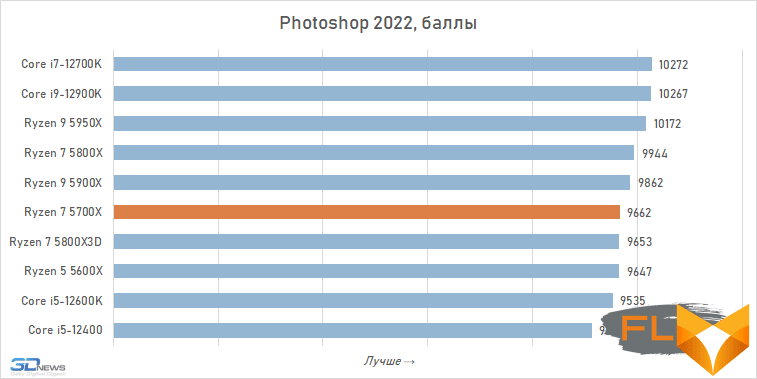
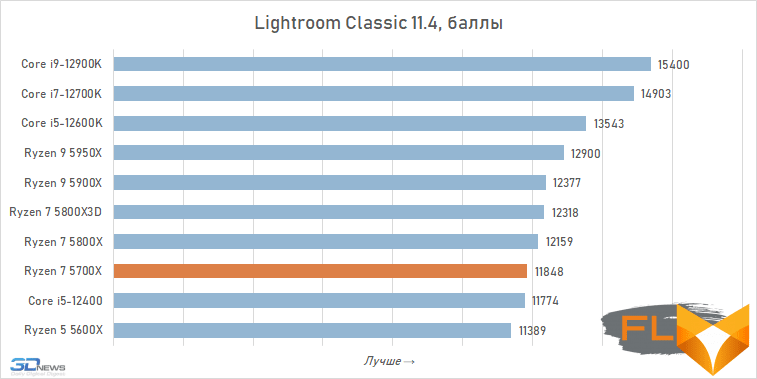
Video work:
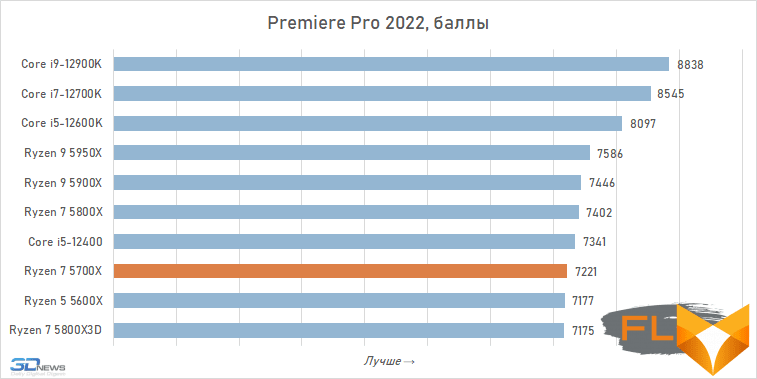
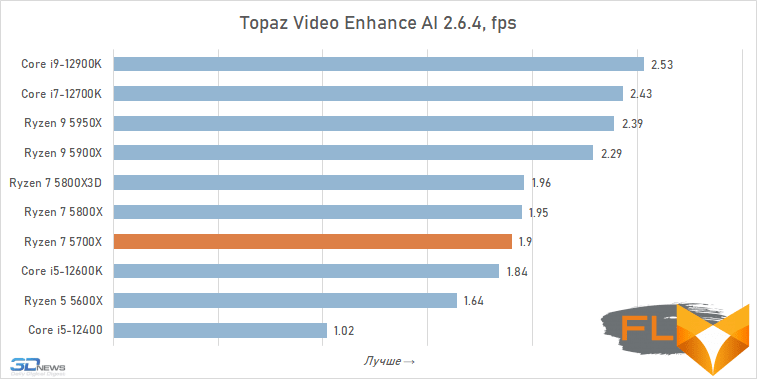
Video transcoding:
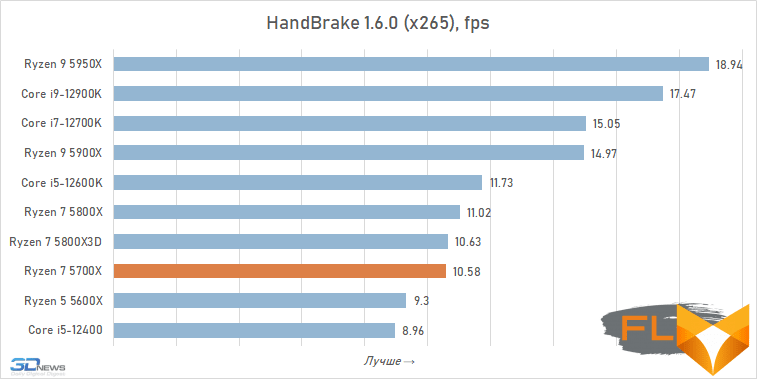
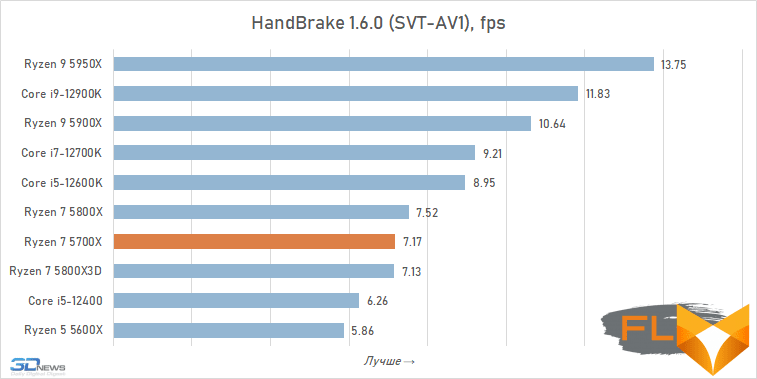
Compilation:
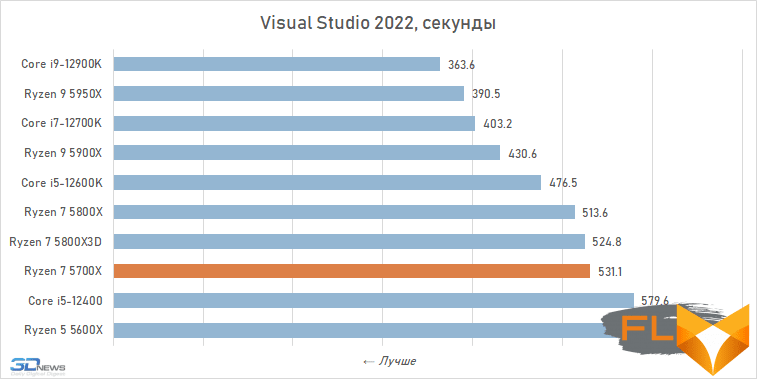
Archiving:

Chess:
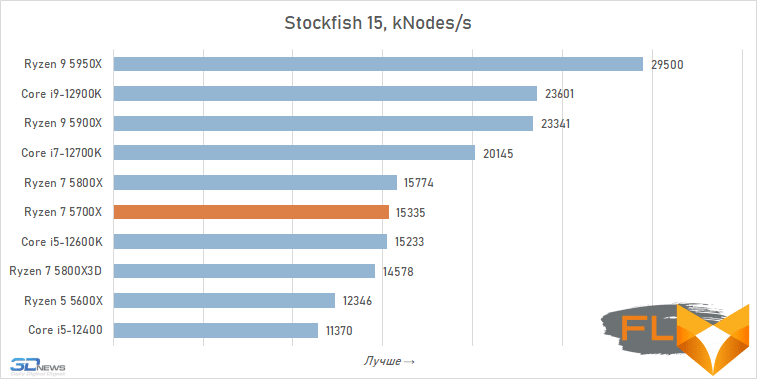
Mathematical calculations:
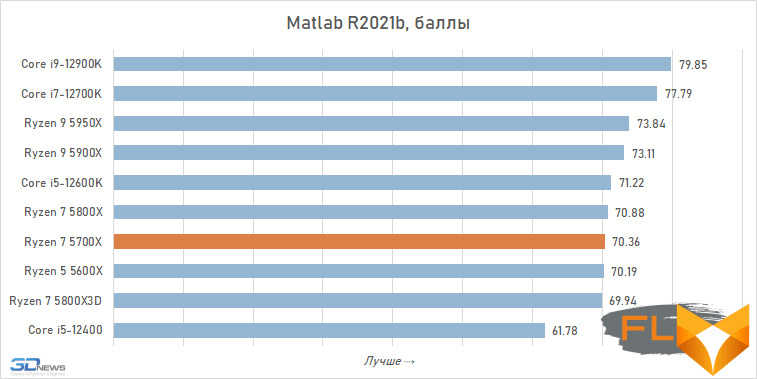
1080p gaming performance
With the advent of Intel Alder Lake, the positions of the representatives of the Ryzen 5000 family in games have noticeably weakened. Only one AMD CPU can compete on equal terms with processors more powerful than the Core i5-12600K in games – a special Ryzen 7 5800X3D, equipped with an additional 64 MB of 3D cache. As for the Ryzen 7 5700X, it, like its older brother Ryzen 7 5800X, falls between the Core i5-12400 and Core i5-12600K in terms of gaming performance. At the same time, the difference in frame rates that the eight-core Ryzen 7 5800X and Ryzen 7 5700X can provide is quite insignificant and is within one percent. Another thing is the eight-core Ryzen 7 5800X3D – this processor performs in a completely different weight category and breaks away from the Ryzen 7 5700X by a significant 13%.
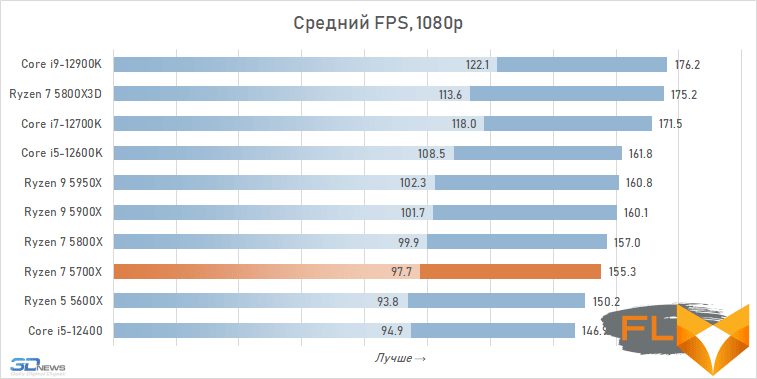
In most cases, the Ryzen 7 5700X is ahead of the Core i5-12400 and behind the Core i5-12600K. At the same time, in the test set of 12 games there are two projects (Chernobylite and Shadow of the Tomb Raider), in which the Ryzen 7 5700X still shows better FPS than the Core i5-12600K. But, on the other hand, in four games, the Ryzen 7 5700X loses to the noticeably cheaper six-core Core i5-12400.
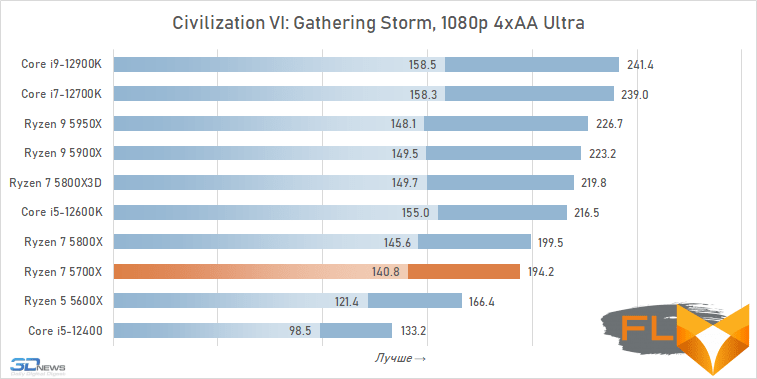
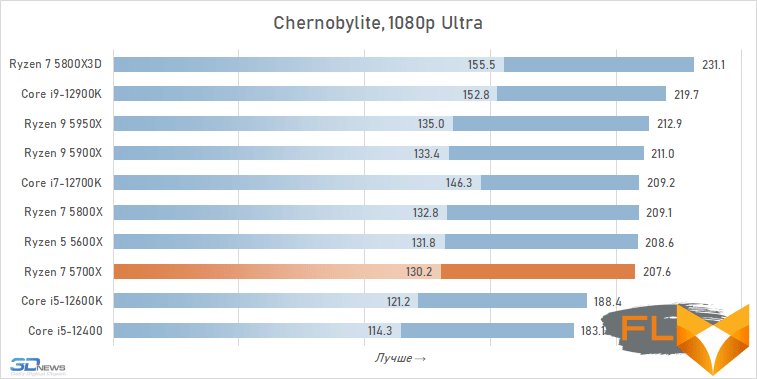

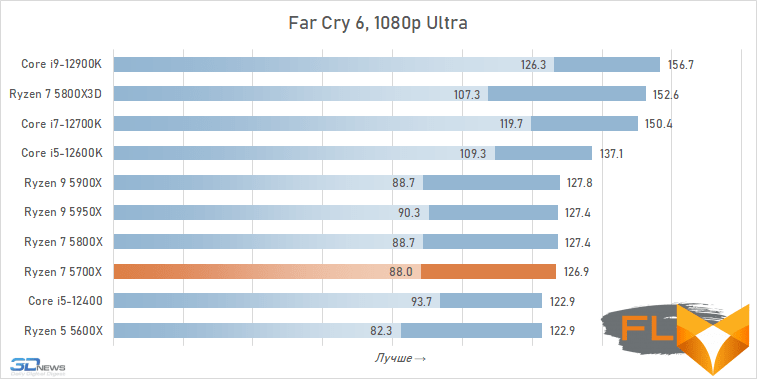

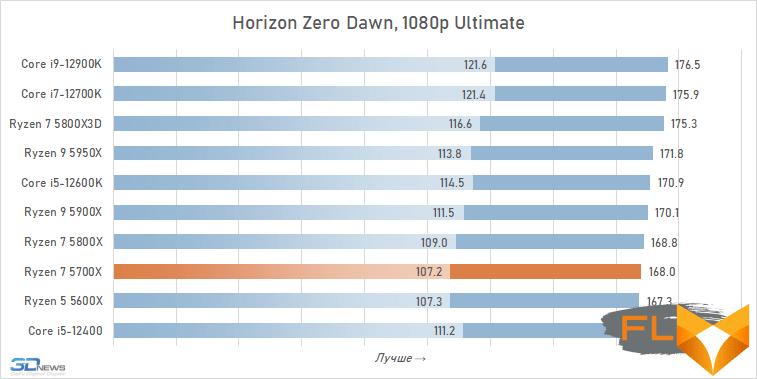
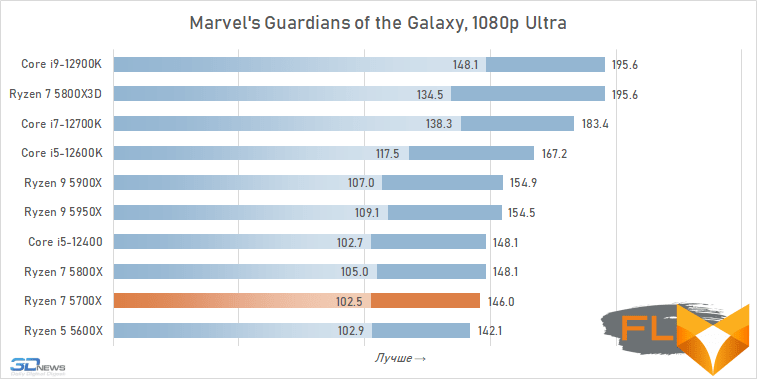
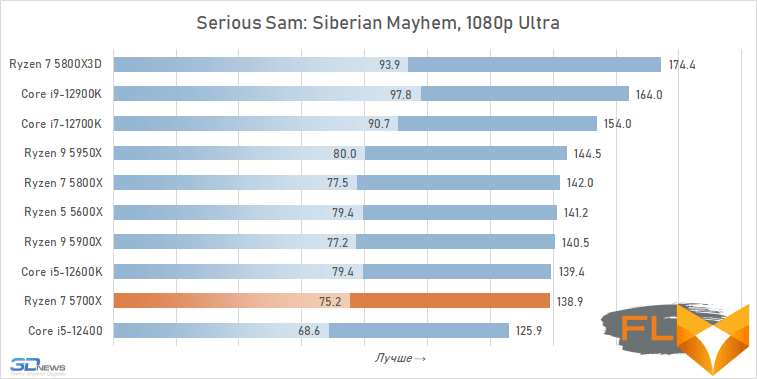
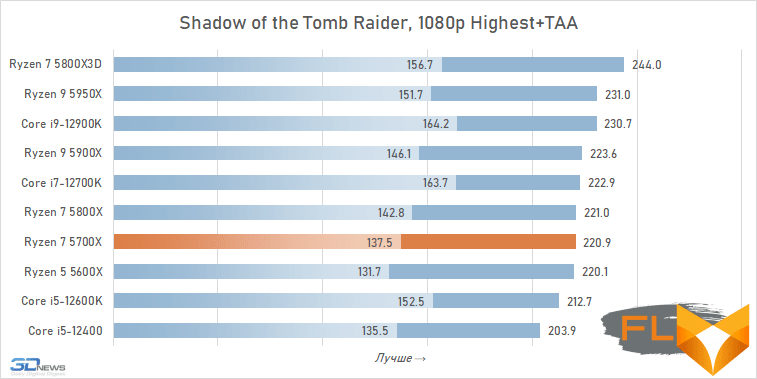
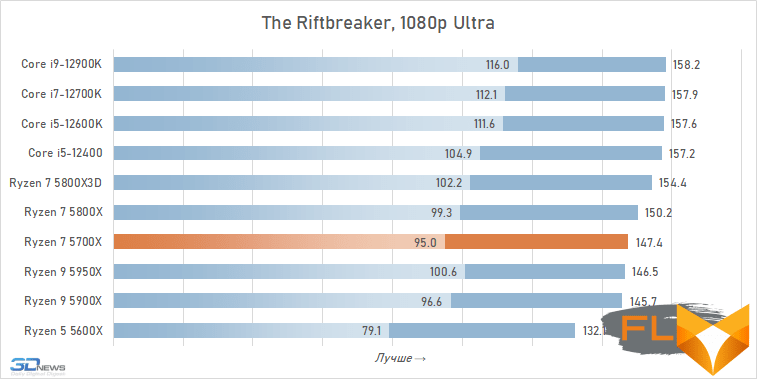
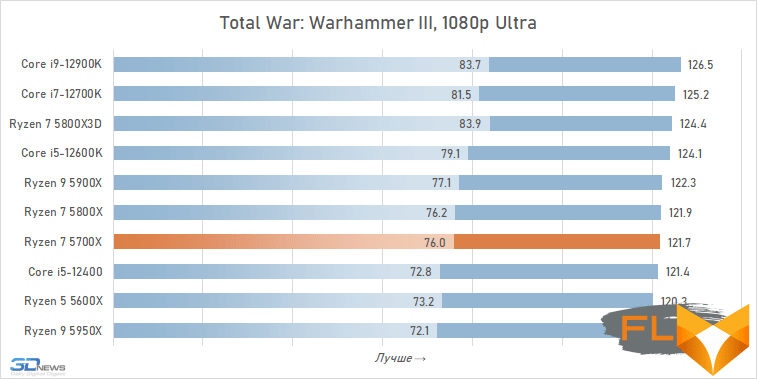
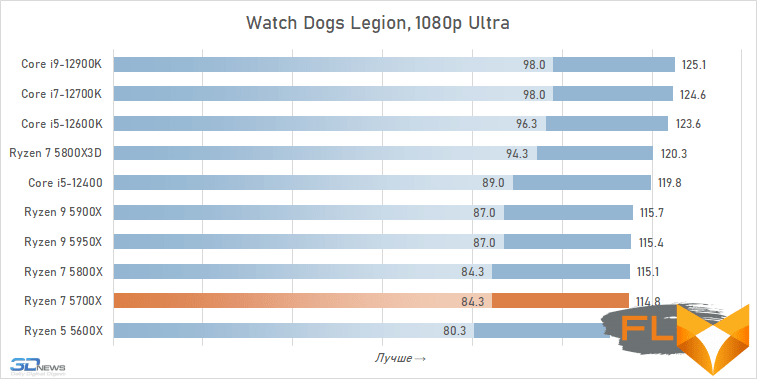
Gaming performance at 2160p
Increasing the resolution leads to leveling the difference in gaming performance of mid-range and high-end processors. Switching to 4K (with maximum image quality) leaves very few games where the overall system performance is not constrained by the power of the GPU. Even the flagship GeForce RTX 3090 graphics card does not have the necessary resources for the choice of processor to somehow noticeably affect the FPS. But qualitatively, the conclusions do not change from this – for modern gaming configurations, Intel processors are more preferable at this stage. Firstly, there are still games that show processor dependence in 4K, and secondly, we will soon see a change in GPU generations, after which the gaming load on processors will inevitably increase.
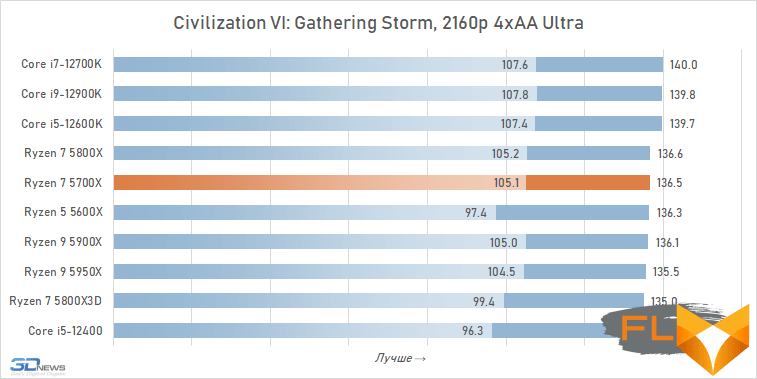
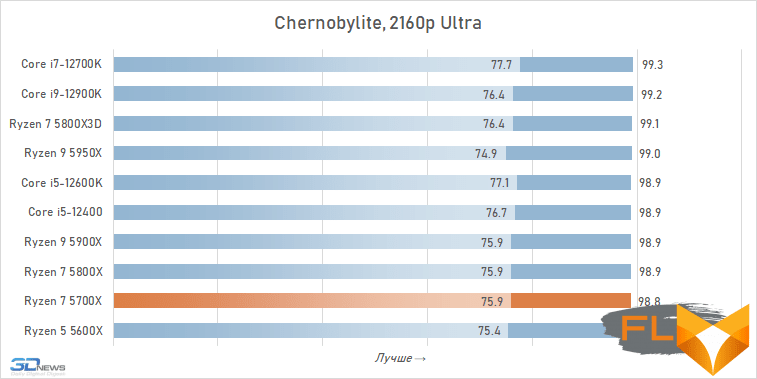
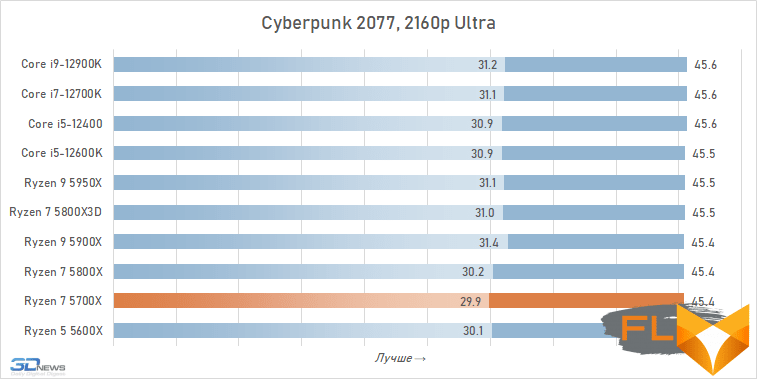
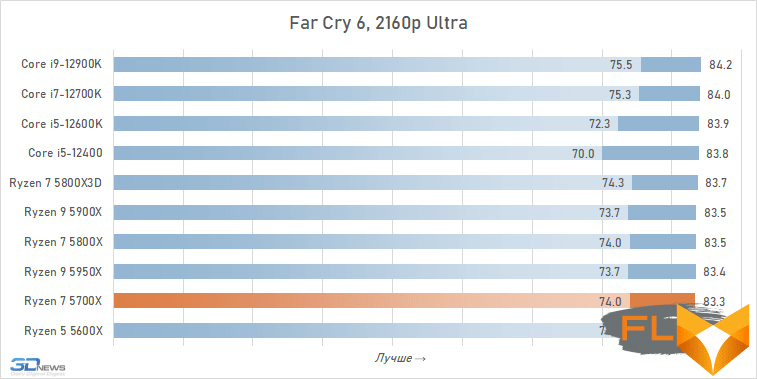
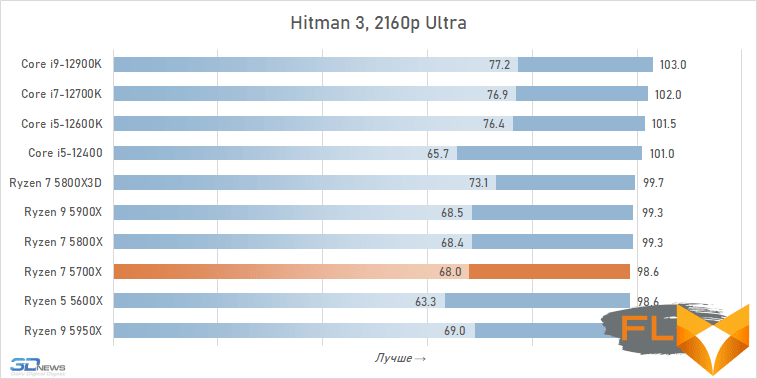
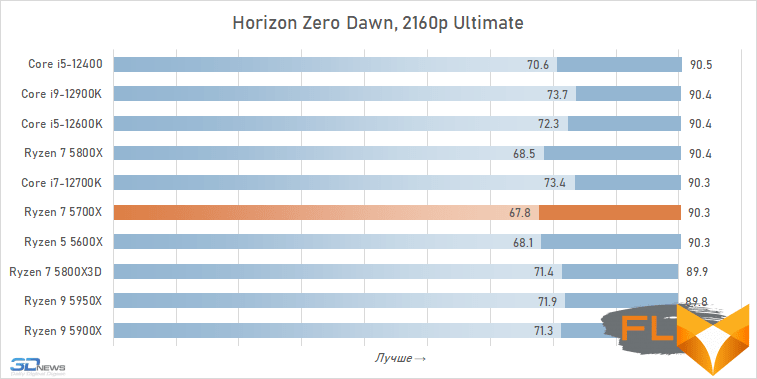

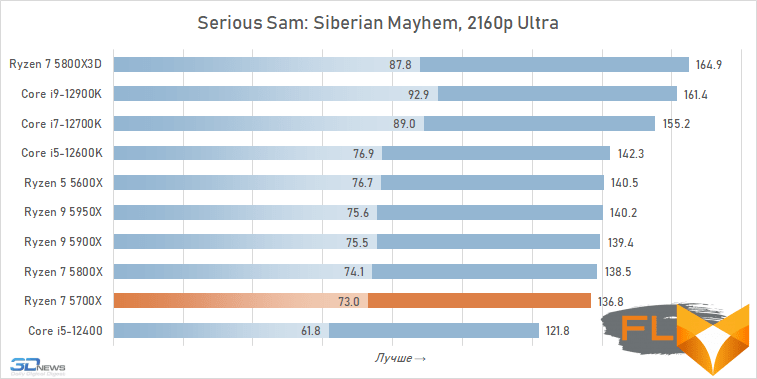
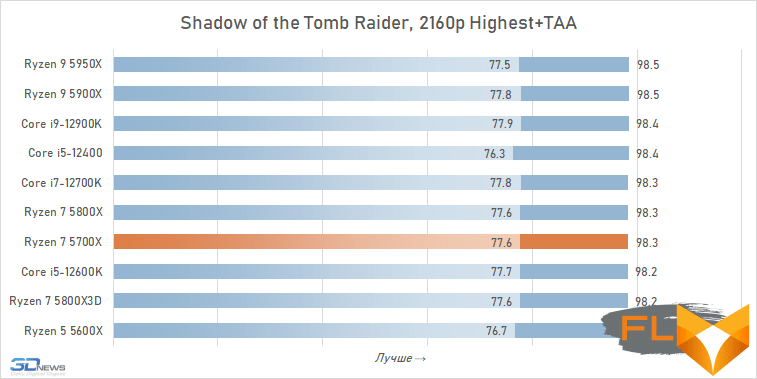
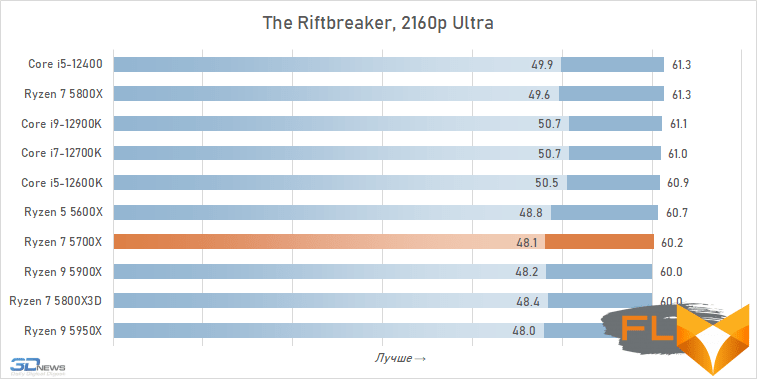
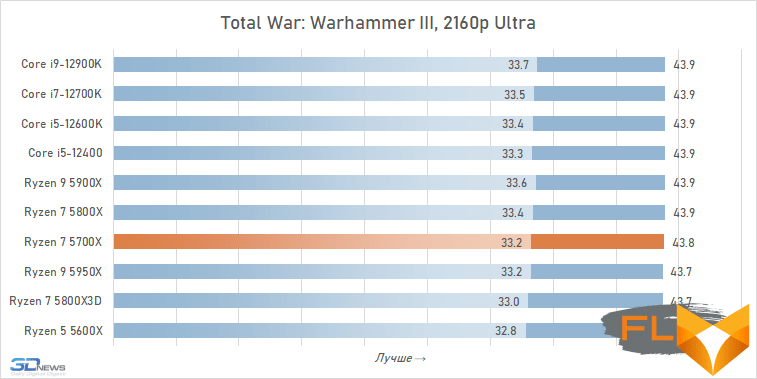
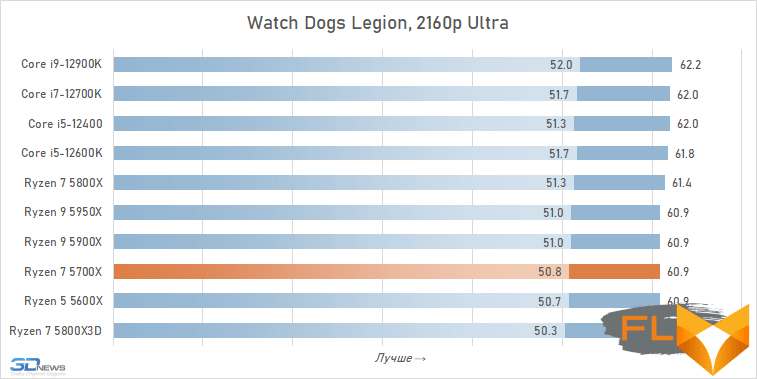
Conclusions
We have been waiting for the Ryzen 7 5700X for a long time. By analogy with the Ryzen 7 3700X, such a processor suggested itself in the lineup back in the fall of 2020, at the time of the announcement of the first representatives of the Ryzen 5000 series. However, then AMD decided to abandon the release of an additional eight-core processor, offering only one option – Ryzen 7 5800X. This must have discouraged some users from switching to the new family of processors, since the Ryzen 7 5800X came out too expensive and too hot. But AMD could not afford to offer a really massive eight-core processor in parallel with the Ryzen 7 5800X – the lack of free capacity at TSMC, where all Ryzen processors are made without exception, affected.
The opportunity to expand the range of desktop processors based on the Zen 3 architecture from AMD appeared only now – in the sunset of the Socket AM4 platform, when most enthusiasts are looking forward to the release of more advanced Ryzen 7000 processors. And this means that the high popularity of the Ryzen 7 5700X no longer threatens. However, among the reasons why market success is not about the Ryzen 7 5700X, there are much more significant ones. For example, the price. The release of the Ryzen 7 5700X coincided with the markdown of other Ryzen 5000 models, as a result, it turned out that the new product costs almost the same as the Ryzen 7 5800X, and in a number of stores the older eight-core can be bought even cheaper than the younger novelty! Naturally, with this positioning of buyers for the Ryzen 7 5700X, there are few, and besides, for an even smaller amount, you can find the Core i5-12600KF on sale, which is more productive than both the Ryzen 7 5700X and the Ryzen 7 5800X.
All this clearly indicates that the Ryzen 7 5700X is too expensive. To make this processor look relevant, it should cost at the level of the Core i5-12600, that is, not $299, but about $220. Apparently, AMD itself understands this and is gradually moving towards this goal. At least the price dynamics of the Ryzen 7 5700X on AliExpress gives positive signals.
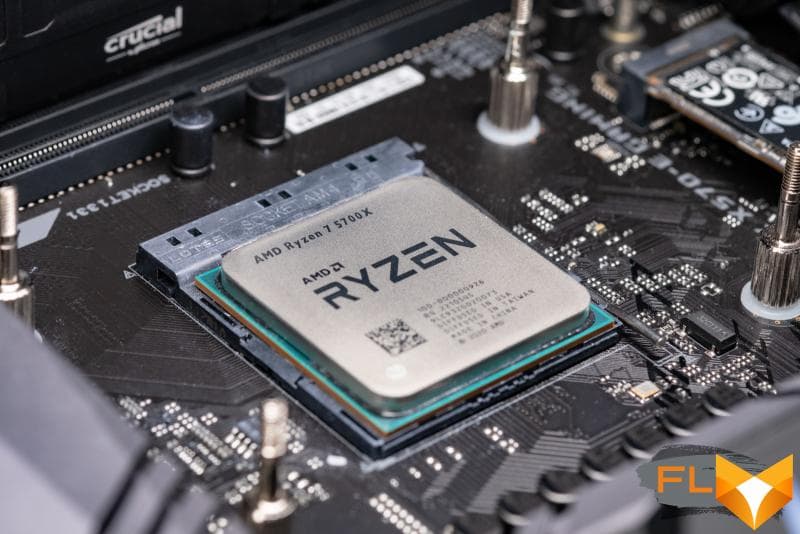
And when AMD finally revises its price list, it will be possible to seriously think about the advantages of the Ryzen 7 5700X, which it certainly has. For example, in terms of performance, the Ryzen 7 5700X is almost as good as the Ryzen 7 5800X. When Precision Boost Override is enabled, the difference in performance between these models is reduced to a few percent, and in games it generally becomes almost indistinguishable. If you use the Ryzen 7 5700X with passport consumption restrictions activated, it turns out to be a very cold and economical processor that can be installed in small form factor computers and save on cooling systems. And such a use case also has a right to exist, since in this case only the computing component of performance noticeably suffers, and the gaming performance of the Ryzen 7 5700X remains almost the same as that of the Ryzen 7 5800X.
Ultimately, the Ryzen 7 5700X may be a good fit for upgrading older systems that still use Socket AM4 processors on Zen 1 and Zen 2 architectures. Switching to a new product, even from eight-core Ryzen of the first or second generation, will seriously increase performance and certainly will not cause overheating problems, even if you use old boxed coolers with it. Moreover, now, after updating the AGESA libraries to version 1.2.0.7 (and higher), Ryzen 5000 processors are supported by almost any motherboard equipped with a Socket AM4 processor socket.
FAQ Amd ryzen 7 5700x review
What are the specifications of the AMD Ryzen 7 5700X CPU in terms of cores and threads?
The AMD Ryzen 7 5700X CPU features 8 cores and 16 threads, providing robust multitasking and processing capabilities for both gaming and productivity applications.
How does the base clock speed of the Ryzen 5 5600 compare to the Ryzen 7 5700X?
The Ryzen 5 5600 has a base clock speed of 3.4 GHz, which is identical to the Ryzen 7 5700X, both offering solid performance at this base frequency.
What is the boost clock speed of the AMD Ryzen 7 5700X processor?
The AMD Ryzen 7 5700X processor has a boost clock speed of up to 4.6 GHz, enabling it to handle demanding tasks and provide fast performance when needed.
Is the AMD Ryzen 7 5700X compatible with DDR4 memory?
Yes, the AMD Ryzen 7 5700X is compatible with DDR4 memory, allowing users to benefit from this type of RAM’s speed and efficiency.
How does Tom’s Hardware rate the AMD Ryzen 7 5700X compared to an Intel CPU in single-core performance?
Tom’s Hardware generally rates AMD’s Ryzen 7 5700X as a strong competitor to Intel CPUs in single-core performance, with the 5700X offering excellent performance and efficiency.
Why might someone consider the Ryzen 7 5700X the best CPU for an affordable 8-core option?
The Ryzen 7 5700X is considered one of the best CPUs for those seeking an affordable 8-core option due to its balanced combination of performance, power efficiency, and competitive pricing.
What is the power draw of the Ryzen 7 5700X processor, and how does it impact its efficiency?
The Ryzen 7 5700X processor has a lower TDP (Thermal Design Power) compared to some older Ryzen models, leading to efficient power draw and making it an energy-efficient choice.
How does the AMD Ryzen 7 5700X processor compare to the Ryzen 5 5600 in terms of value?
The AMD Ryzen 7 5700X processor, with its additional cores and higher boost clock, offers better value for users needing more power for tasks like gaming and content creation, compared to the Ryzen 5 5600.
Is the Ryzen 7 5700X processor compatible with AM4 motherboards?
Yes, the Ryzen 7 5700X processor is compatible with AM4 motherboards, offering flexibility and ease of integration with a wide range of existing systems.
What advantages does the Ryzen 7 5700X have over two AMD CPUs in a similar range?
The Ryzen 7 5700X has advantages like a higher boost clock (up to 4.6GHz), efficient power usage, and 32MB of L3 cache, which may make it a more powerful and efficient choice compared to two AMD CPUs in a similar range.
